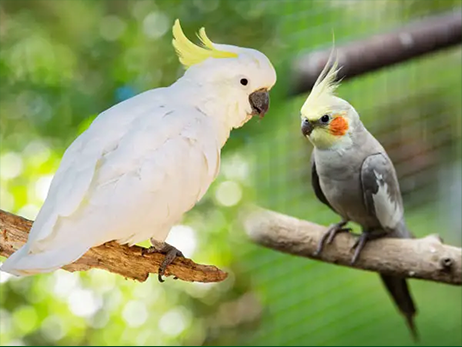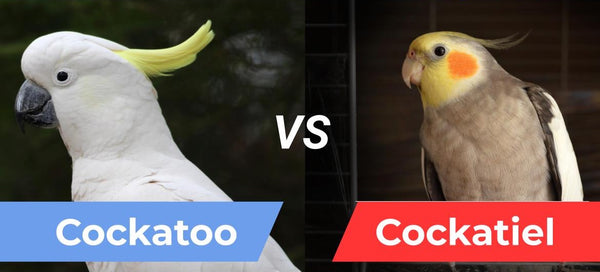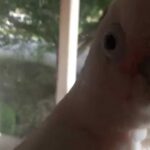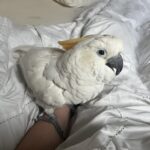Cockatiels are smaller, crested parrots of the Nymphicus genus, while cockatoos belong to the larger Cacatuidae family. Cockatiels typically feature a distinctive head crest and simpler coloration compared to the more diverse and vibrant-hued cockatoos.
Understanding the differences between a cockatiel and a cockatoo is essential for bird enthusiasts and potential pet owners. Cockatiels, native to Australia, are popular pets known for their manageable size, friendly disposition, and ability to mimic sounds. On the other hand, cockatoos are recognized by their larger size, expressive crests, and louder calls.
With their wide range of sizes and species, cockatoos also demand more space and mental stimulation. Both these birds require dedicated care, but the smaller cockatiel might be better suited for those with limited space, whereas cockatoos may be a fit for experienced bird owners seeking a more interactive companion. Choosing between these charming birds depends on personal preference, lifestyle, and readiness for avian companionship.
Introduction To Cockatiels And Cockatoos
Feathers, chirps, and charm: cockatiels and cockatoos are the feathered jewels of the bird world. These birds bring joy and laughter into homes around the globe. Yet, many wonder: what sets them apart? This post will feather out the details between these captivating creatures.
Native Habitats And Origins
Cockatiels and cockatoos share Australian roots. They thrive in varied environments, from bushlands to rainforests. Their presence in the wild paints a picture of adaptation and survival across landscapes.
- Cockatiels: Often found in the Australian Outback, surrounded by scrublands and open wetlands.
- Cockatoos: Prefer denser forests and even urban areas, showcasing their flexibility and resourcefulness.
Physical Appearance: A Comparative Glance
At a glance, cockatiels and cockatoos might seem similar, yet they sport distinct characteristics. Here’s a quick dive into their visual differences:
| Cockatiels | Cockatoos | |
|---|---|---|
| Size | Smaller, sleek | Larger, robust |
| Crest | Long, slender | Large, expressive |
| Colors | Gray, white, yellow | Variety including white, black, pink |
| Beak | Small, pointed | Curved, powerful |
Size And Stature
Understanding the physical differences between cockatiels and cockatoos is fascinating. Size and stature are key features that set them apart. Let’s explore their unique sizes.
Average Size Of Cockatiels
Cockatiels charm people with their compact size. They are the smallest members of the cockatoo family. Here are their typical measurements:
- Length: About 12 to 13 inches from head to tail.
- Weight: Usually ranges between 2.5 to 3.5 ounces.
- Wingspan: Can reach up to 18 inches across.
The Larger Build Of Cockatoos
Cockatoos boast a more robust and grandiose stature. These larger parrots have a noticeable presence:
| Species | Length (inches) | Weight (ounces) | Wingspan (inches) |
|---|---|---|---|
| Little Corella | 14-16 | 11-14 | 32-36 |
| Sulphur-crested Cockatoo | 17-22 | 28-36 | 37-41 |
| Umbrella Cockatoo | 18-24 | 14-28 | 39-42 |
Note: The above table includes just a selection of cockatoo species, as sizes can vary widely.
Feather Features
The beauty of birds often lies in their feathers, and certainly, cockatiels and cockatoos are no exception. Their plumage not only serves functional purposes but also distinguishes them visually. Let’s delve into the feather features that set these captivating birds apart.
Color Variations In Cockatiels
Cockatiels, a smaller cousin within the parrot family, boast an array of color patterns. Originally, these birds feature a grey body with a stunning contrast of white on their wings and vibrant orange cheek patches. Yet, selective breeding has introduced a beautiful spectrum:
- Normal Grey: the classic wild-type coloration.
- Lutino: a charming yellow or white body with red eyes.
- Pearl: spotted with a pearl-like pattern across the feathers.
- Pied: a mix of colors disrupting the normal grey pattern.
- Cinnamon: a warm, brownish hue to the feathers.
- Whiteface: pure white or grey, devoid of the orange cheek patch.
Distinctive Plumage Of Cockatoos
In contrast, cockatoos carry a more uniform color scheme with most species adorned in a predominant white. Notably, there are striking exceptions:
| Cockatoo Species | Main Color | Distinctive Features |
|---|---|---|
| Galah | Pink and Grey | Pink chest and face, with a grey back. |
| Sulfur-crested | White | Yellow crest and tinges of yellow under the wings. |
| Black Cockatoo | Black or Dark Brown | Often with splashes of red or yellow on the tail. |
Another hallmark of cockatoos is their erectile crest; a fan of feathers on top of their head that they can raise or lower at will. This expressive feature is not found in cockatiels to the same extent or grandeur.

Credit: www.youtube.com
Crest Expressions
Birds often communicate in fascinating ways. Among parrots, the crest plays a crucial role. In particular, cockatiels and cockatoos use their crest for various expressions. Whether showing excitement or caution, these birds adjust their crest to convey messages. In this section, we’ll dive into the subtle art of crest communication used by these feathered friends.
Cockatiel’s Dynamic Crest
The cockatiel, with its slender crest, offers clues about its mood through crest positions. Observe these crest movements:
- Flat: A relaxed state or possibly feeling defensive.
- Slightly Raised: The bird is alert or curious about its surroundings.
- Fully Erect: Indicates excitement, fear, or aggressive tendencies.
This form of body language helps owners understand and respond to their cockatiel’s needs.
Cockatoo’s Dramatic Crest Display
The cockatoo’s crest provides a more theatrical show. Cockatoos can fan out their crest to showcase:
| Crest Position | Meaning |
|---|---|
| Flat Against the Head | Contentment or a relaxed state of mind. |
| Partially Raised | Interest or mild excitement. |
| Fully Erect | Defensive stance, extreme excitement, or fear. |
These dramatic displays not only signal their mood but can also be a form of intimidation to deter predators or rivals.
Vocalization And Noise Levels
Vocalization and noise levels are key differences between cockatiels and cockatoos. Both birds have unique ways of expressing themselves. Understanding these can help decide which bird fits best in your home.
Cockatiels’ Whistles And Calls
The charming sounds of cockatiels can be music to the ears. They are known for their melodic whistles and soft calls. These birds enjoy mimicking sounds from their environment.
- Contact calls: Soft and repetitious, often used to stay in touch with flock members or humans.
- Whistling range: Versatile, she can learn tunes and create her own.
- Volume: Generally low, making them suitable for apartments.
Cockatoos’ Loud Vocal Range
Cockatoos are the extroverts of the bird world with a powerful vocal presence. Their calls can go far, so they are not ideal for close-quarter living.
| Type of Vocalization | Description | Volume |
|---|---|---|
| Contact Calls | Sharp and drawn out to connect with others over distances. | High |
| Screams | Expresses excitement or stress, can be intense. | Very high |
| Talking Ability | Can learn words and phrases, adding to vocal diversity. | Variable |

Credit: www.wikihow.pet
Behavioral Traits
Understanding the distinct behaviors of cockatiels and cockatoos reveals a fascinating world of avian antics. These charming birds share some traits but also have unique behavioral signatures. Let’s explore the lively personalities of both species to appreciate their differences better.
Social And Interactive Cockatiels
Cockatiels are known for their sociable nature. They bond closely with their human families. Often, they will whistle or sing to their loved ones, displaying a joyous blend of affection. These birds enjoy being part of daily activities and will happily sit on a shoulder while their owners go about their business.
- Friendly and gentle demeanor
- Enjoys mimicry and learning tricks
- Can entertain themselves with toys
- Requires regular interaction to stay happy
Cockatoos’ Demands For Attention
Cockatoos are incredibly emotive birds with a flair for drama. They crave attention and may develop behavioral issues if neglected. Their calls are louder than those of cockatiels, serving as a means to express a need for companionship. Cockatoos enjoy physical contact, often seeking out cuddles and head scratches from their owners.
| Behavior | Description |
|---|---|
| Loud Vocalizations | Use their voice to signal need for attention. |
| Physical Affection | Desire consistent cuddles and touch. |
| Chewing and Destruction | Need ample toys to satisfy chewing tendencies. |
| Social Dependence | Seek a deep bond and plenty of time with caregivers. |
Both cockatiels and cockatoos have distinctive social behaviors that are endearing and require understanding. By recognizing their individual needs, owners can ensure a harmonious relationship with these delightful birds. Whether a vibrant cockatiel or a captivating cockatoo, the key is regular interaction and engagement.
Lifespan And Health Considerations
Understanding the lifespan and health of your bird is key. It helps plan for the long-term commitment required to care for them. Cockatiels and Cockatoos differ greatly in these areas.
Typical Lifespan Of Cockatiels
As smaller parrots, Cockatiels usually enjoy a moderate lifespan. With proper care, these birds can live 15 to 20 years on average. Factors contributing to a longer life include:
- A diet rich in nutrients
- Regular veterinary check-ups
- Clean living conditions
- Social interaction and mental stimulation
Genetics and environment also play roles.
Longevity Of Cockatoos
Cockatoos are known for their impressive longevity. These larger parrots can live upwards of 40 to 60 years, and sometimes even longer with optimal care. Major health considerations for Cockatoos include:
| Health Consideration | Details |
|---|---|
| Dietary Needs | Requires a balanced diet to prevent obesity |
| Exercise | Needs regular activity to maintain physical health |
| Mental Health | Requires mental stimulation to prevent depression |
| Social Needs | Strongly bonds with owners; requires ample attention |
With a commitment to good health practices, Cockatoos can be a companion for life.

Credit: www.farmghar.com
Care Requirements
Understanding the care requirements for a cockatiel versus a cockatoo is crucial before adopting one of these birds. They may look similar, but their needs are quite different. Keep reading to learn how to best care for each kind of bird.
Caring For A Cockatiel
Cockatiels are smaller and require less space than cockatoos. A large cage that allows them to flap their wings is necessary. Locate the cage in a lively room away from drafts and direct sunlight.
- Diet should consist mainly of high-quality pellet food, supplemented with fresh fruits and veggies.
- Daily interaction is important—they’re social birds and can become lonely.
- Keep their environment clean by changing water daily and cleaning the cage weekly.
- Regular vet check-ups are essential to maintain good health.
Special Needs Of Cockatoos
Cockatoos are larger and need more attention. Their care includes both physical and emotional aspects.
| Requirement | Details |
|---|---|
| Space | An even larger cage or aviary is a must, as they are prone to cage stress. |
| Socialization | They demand more time with their human families and can develop behavioral issues if lonely. |
| Stimulation | Need for stimulating toys to keep them busy and prevent feather plucking. |
| Diet | Similar to cockatiels but due to size, require larger portions. |
Remember, cockatoos can live up to 60 years or more. Thus, long-term commitment is vital. Cockatiels generally have a shorter lifespan, around 20 years, but they still require a dedicated caregiver.
Suitability As Pets
Choosing the right pet bird is crucial for a happy home. Cockatiels and Cockatoos stand out as charming feathered friends. Yet, their care differs greatly. This section digs deep into the suitability of each bird as a pet.
Choosing A Cockatiel For Home
Cockatiels are ideal for homes of all sizes. Their gentle character and manageable size make them great companions.
- Affectionate without being overly demanding
- Do well with regular interaction
- Require daily exercise and mental stimulation
Cockatiels have a moderate life span, living up to 20 years. They offer long-term companionship without a lifetime commitment.
| Feature | Cockatiel |
|---|---|
| Size | Small – Medium |
| Lifespan | Up to 20 years |
| Care Level | Moderate |
Understanding The Commitment To A Cockatoo
Cockatoos require a dedicated owner. Their large size and longer lifespan demand commitment.
- Known for loud vocalizations and strong personalities
- Need ample space for exercise and play
- Social creatures craving consistent interaction
With a lifespan that can exceed 60 years, Cockatoos are a lifetime investment. Their care requires noticeable daily time and financial commitment.
| Feature | Cockatoo |
|---|---|
| Size | Large |
| Lifespan | Up to 60+ years |
| Care Level | High |
Conclusion
Wrapping up, distinguishing between cockatiels and cockatoos is essential for potential bird owners. They differ in size, personality, and care needs. Understanding these differences ensures a suitable match for your home and lifestyle. Remember, thoughtful consideration leads to a harmonious human-bird relationship.
Choose your feathered friend wisely!
Ryan Everhart is a passionate bird enthusiast and blogger, primarily writing on his website, Avian Whispers. His journey into the world of bird blogging began with a deep interest in parrots, a species that captivated his attention for their intelligence and social behavior. Over time, his content expanded to cover a broader range of bird species, offering insights into bird behavior, care, habitats, and conservation.
Ryan is dedicated to educating his audience, which includes both new bird owners and seasoned enthusiasts. His writing is filled with personal experiences, expert knowledge, and practical advice on bird care. Through Avian Whispers, he aims to foster a deeper appreciation for birds, emphasizing their role in nature and the joys of having them as pets.
Starting with articles focused on parrots, Ryan’s work now encompasses a diverse range of topics such as feeding, training, habitat enrichment, and bird health. His love for birds extends beyond parrots, diving into various avian species. His informative and heartfelt writing reflects his commitment to the well-being of birds and the desire to help others connect with these creatures.
As a growing voice in the bird blogging community, Ryan strives to provide a platform where bird lovers can learn, share experiences, and connect over a shared passion for avian life. His blogs are not only educational but also serve as a reminder of the importance of protecting and nurturing the bond between humans and birds.




